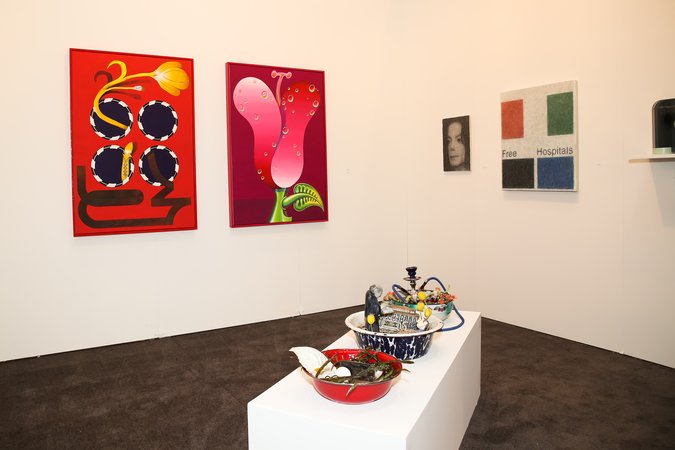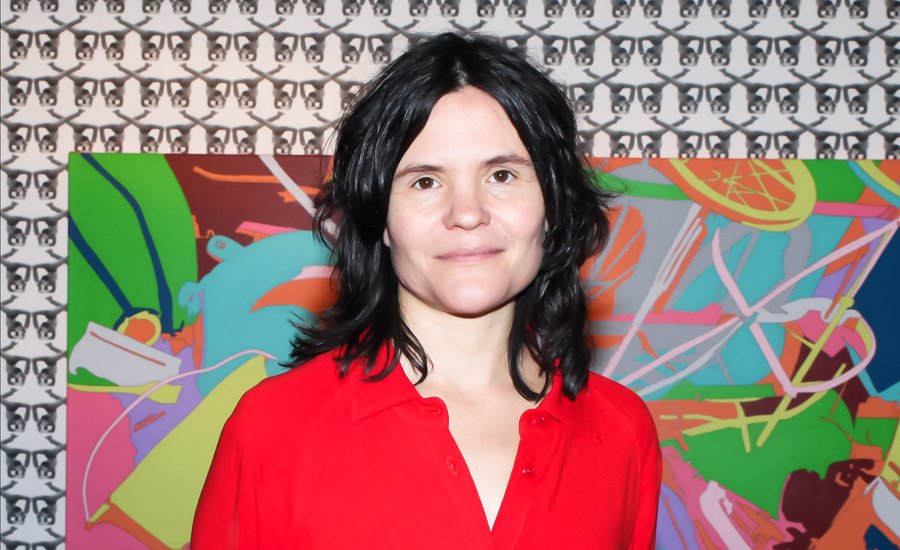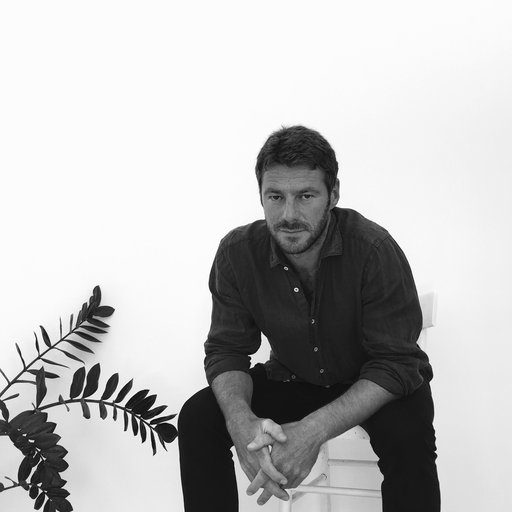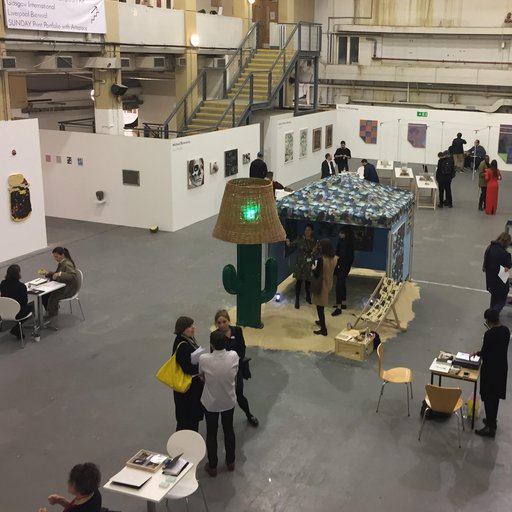No chronicle of the forces shaping the fates of galleries is complete without a hard look at the art fair. Enabled by the internet and buoyed by the ever-increasing number of destination art events around the world, fairs have become the tent pole of the art market, and galleries are scrambling to keep up with their demands.
For younger dealers especially, fairs are a blessing and a curse. Though the costs can be high (expenses include accommodations, shipping, V.I.P.-wooing, and the fair booth itself) there’s a chance to sell work and simultaneously expand their cadres of collectors and art lovers who may not necessarily come across the small storefront in Baltimore, Mexico City, Tokyo, or Johannesburg in the course of their own travels. As a result, fairs represent a sea change in the industry that’s opening up new possibilities (and perils) for gallerists looking to make their way.
To find out more about what these shifts mean, Artspace’s Dylan Kerr spoke to Heather Hubbs, the longtime New Art Dealers Association (NADA) director who, since her appointment in 2004, has witnessed firsthand the rise of the art fair as we know it. As someone who works closely with all manner of emerging galleries in her role, Hubbs—perhaps not surprisingly—is bullish about the longevity of the present gallery model. Here’s why.
Art fairs are nothing new, but in the years since NADA started they’ve taken off to become are a central part of the international conversation around art and the art market. How have you seen galleries adapt their approach to fairs as they’ve grown more comfortable with the context?
I think it boils down to the gallerist. Some people are going to adapt and bring things they think will sell, others may not take that too much into consideration and just do whatever to do with an artist, whether they think it's going to sell or not. I think it's understandable to be concerned with sales in times like we’re in now, where it’s slow and everybody is struggling—I don't think it's a time to judge anybody for bringing something that is going to be easy to sell. Everybody needs to be realistic, because everybody wants to stay in business.
In their own way, fairs are a disruption of gallery system in the sense that they remove artworks from the carefully constructed context of the gallery and place them alongside one another in rows and rows of booths, each trying to capture the attention of the same group of collectors, curators, and reporters. Since you started at NADA, how have you seen galleries’ programs change as a result?
I think most exhibitors still think about their program in the gallery very differently than they think about fairs. Most galleries approach fairs in a very specific way, and the way in which they do fairs can vary a lot just based on the city that the fair is in, whether or not they have clients there, what they know about the city, and even the venue and the space they’re going to have. Some fairs are very straightforward, with square-ish booths, and others are more funky situations, so I definitely think that all of those things always come into play when thinking about the fair. Sometimes it just boils down to shipping costs—what are you going to take if you need to keep your expenses low? That might affect what you actually do in the booth.
In the gallery, the bigger challenge is probably to make sure that the shows you do feel different from one another and that the space is somewhere that the artist can actually do what they want to do. I think that's always a challenge. I don’t know that gallerists really think about fairs and their programs together. They affect one another, in a way, but I think if I had a gallery I would really be thinking about these two spaces very differently.
 C L E A R I N G, NADA Miami Beach 2015
C L E A R I N G, NADA Miami Beach 2015
It’s an interesting point, that gallerists treat different venues differently. How do you see the kinds of work change between, for example, NADA Miami and NADA New York?
Maybe there's not a big difference between New York and Miami, but let’s consider a U.S. fair as opposed to a European fair. As a U.S.-based person, if I’m going to do a fair in Europe, I’ll probably bring artists that I think will have name recognition there. I’m not saying that every gallerist out there would do that—somebody else might say they’re going to bring someone no one's ever heard of because they want to introduce this artist to that audience. For example, if you're Paris-based gallery doing FIAC and you're not struggling so much, your ability to do a risky booth is much greater than somebody coming from the States or from Australia. You might see more intensive, hard-to-sell things from people closer to the home base than from people from far away. That's not always the case, obviously, but it is the reality of being local.
As a fair director, how do you think of galleries that bring very commercial, salable work versus galleries that bring more conceptual or lesser-known works they know are going to be a harder sell? How do you plan for that balance when you’re putting the fair together?
These things definitely come into the conversation. You want to put together a fair that has a lot of variety—you don't want to have a fair full of just one medium. You do the best you can with what's being proposed, and I actually think our committee does a really good job of paying attention to everything that's being presented, making carefully considered decisions about what they choose so that it isn't all the same.
 Opening Day, NADA Miami Beach 2014
Opening Day, NADA Miami Beach 2014
How has the role of art fairs changed since you started working with NADA? How have your goals evolved over these past several years as a result of the new importance of the art fair?
For NADA, we’re really trying to maintain the fair as a platform where galleries make money. To me, that's what art fairs are supposed to do, and if the galleries doing the fair aren't making any money I would question whether or not the fair makes sense. I don't know if that has ever really changed for NADA.
As you know, the thing about NADA is that we’re a nonprofit organization that’s here to serve galleries—it was founded that way, so that's always been and still is our mission. As long as the fairs are doing that, then it suits the mission and it's worth doing. If that ever were to change, I don't think that we would do it.
You referred to the fact that these events are very expensive for galleries to participate in. When I talk to gallerists about art fairs, they often cite the high costs of doing so many throughout the year but say they feel compelled to participate due to the potential to make sales and, perhaps more importantly, to raise the profile of the gallery in the eyes of collectors they might never come in contact with otherwise. How are you seeing galleries reorient their business practices around this risky investment?
Based on what I’ve seen throughout my career, young galleries obviously can’t afford to do many fairs, so they'll start slowly somewhere. Eventually they get to a certain point where they’re doing a lot more—they're really out there doing many things and getting their name out there. After that, they usually start pulling back and reducing the number of fairs they’re doing.
First of all, doing fairs is hard. Running a program wherever you live and then traveling around to all these fairs and to do whatever else you have to do for your artists is a lot of work. I think at some point you just have to become realistic about what you’re doing, unless you have a big staff. People usually end up trimming back and just doing the ones where they make money, or that they feel they need to do for whatever reason. Eventually, they’ll hopefully have grown to a point where they can start adding in a couple more. It really fluctuates depending on where dealers are in their own careers. Big galleries like David Zwirner have so many people working for them that they can do a lot of things, because the whole team doesn't have to be at every single fair or event.
 Bodega, NADA Miami Beach 2015
Bodega, NADA Miami Beach 2015
Have you gotten the sense that there’s any gallery out there that’s actually putting more energy into fairs than they are into the programming of their physical space? If the core business of a gallery is to make sales and promote its artists, it might be tempting to eschew a single brick-and-mortar space in favor of doing a slew of international fairs—though, of course, building a roster might be more difficult then.
I hope not. I hope that the gallery would know that their space, their home base, is really the most important thing. I hope that’s what they’re really thinking about at the end of the day.
The pressure to do fairs is really strong, and that's tough. It's coming from different places—from collectors who say, “Why aren’t you doing this fair? Why aren’t you doing that fair?” and also from their artists, who want to do them too. That pressure is hard, and I think the best thing galleries can do, right now at least, is to be realistic if they want to stay in business. Hopefully everyone around them can understand that.
How does NADA work with galleries that don’t have a physical space?
We do have a section called NADA Projects. We started that section for exactly that reason. We recognize that there’s a lot of people out there doing idiosyncratic programming that may or may not involve a permanent space, and that those people are contributing to the conversation right now. They may not be able to commit to a full-size booth, and, if they don't have the overhead of a physical space or staff, it's not fair for them to have a regular booth when there's somebody else out there who does. The projects were developed as a way to include these people. I do think that we like to give priority to people who are really sticking to the traditional model that hopefully is still valid and will thrive.
 Callicoon Fine Arts, NADA Miami Beach 2015
Callicoon Fine Arts, NADA Miami Beach 2015
So you don’t think the traditional gallery model is going anywhere anytime soon?
I hope not. They’re where all this came from, and I think they're still super important. I think it would be really sad if that disappeared. Some artists are obviously very capable of operating on their own, and maybe don't need that environment, but a lot of them do. I think it would change a lot of things, even the artwork.
How so?
I don't know. I guess I'm just envisioning everything being online. If you think about something posted on Instagram, just because it's really popular doesn’t necessarily mean that it’s strong work. I wonder if it would change what we actually have access to seeing, and the quality of that. If you think about the number of gallerists who are really out there discovering artists—young, old, outsider—I don't know if that would happen online in the same way as it does with those dealers with these bases. I think it would really change the landscape.
 CANADA, NADA Miami Beach 2015
CANADA, NADA Miami Beach 2015
One of the oft-cited advantages of art fairs is that they allow smaller spaces, especially those operating on the periphery of the art world to have a footprint in these major events. It’s part of what allows these smaller, far-flung galleries to continue operating. How much do you think about those kinds of dynamics when assembling the fair?
We try to make it as international as possible. If you’re applying from Lithuania, for instance, you’re going to get a special look because we want the fair to be as diverse as possible. Obviously NADA’s two fairs are in the States, so most of the applications we get are from U.S.-based galleries. It’s hard—we want the fair to be international and we hope people don’t view us as a New York-based fair. Of course we want New York galleries, but we want as many international galleries as possible, too.
Beyond the art-fair context, what do you see as the particular challenges facing the smaller and midsize galleries that make up the majority of your exhibitors?
The slow market is, for galleries at a certain point in their career, the biggest struggle. They may have spaces that they could afford a couple years ago that they just can’t afford right now. The push to do fairs goes on top of that—if the investment in a booth doesn’t pay off, what are the repercussions?
Some of these galleries have been in business for the same amount of time, but their spaces are very different. Somebody’s might be very big, somebody’s might be really small, one might have a ton of staff, another might just have one other person. Balancing your growth is a real challenge.
 Cooper Cole, NADA Miami Beach 2015
Cooper Cole, NADA Miami Beach 2015
A number of NADA galleries are engaged in other activities in addition to their regular programing. I’m thinking of places like the Journal Gallery and KARMA, which are both engaged in publishing, as well as places like Moran Bondaroff with their art-radio project KNOW WAVE. What are some of the alternative models that you find especially promising?
KARMA is definitely one of them, and I’m glad you brought up Moran Bondaroff. They actually do a lot of other things for the community that they don’t really talk about, and they’ve been doing them for a long time.
Is this also something that you consider when you’re planning out the fair?
For sure. It’s good to have that variety—it’s healthy.
 Overduin & Co., NADA Miami Beach 2014
Overduin & Co., NADA Miami Beach 2014
Where do you see things trending for galleries and art fairs, going forward?
In this climate, I would imagine that people are going to cut down a bit on their fair participation. Unless you just have money to spend, I think everybody is just going to be more careful about what they do and don’t take on. I don’t see most people giving up anytime soon, unless they have to. These decisions are also personal—there may be only so much stress you can deal with.
One thing that’s nice about the art community is that people can reinvent themselves. You can close your doors, go do something else, and then come back and do it again. That’s happened in several different cases, which I really like. It’s not necessarily over when one thing ends. Maybe it’s just a new chapter.
People are probably going to get creative, and maybe you’ll see people downsizing or partnering, but I don’t think that’s going to change the way people structure their galleries. Maybe people will do things like split a space in another city and trade off on exhibitions, but they’ll still be doing basically the same thing. I think galleries are such a special community that we get to exist in, and I hope that they stay around.



























